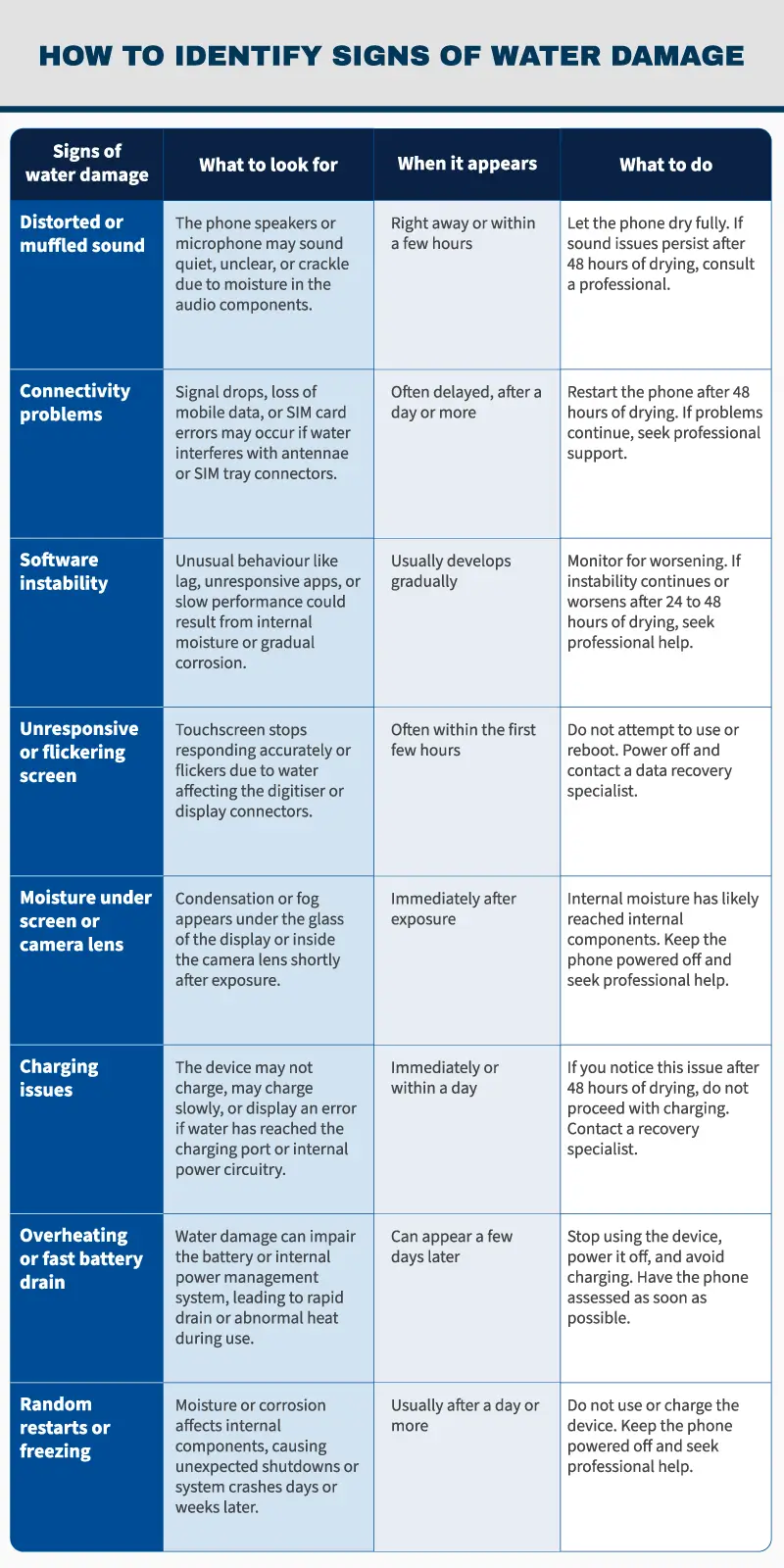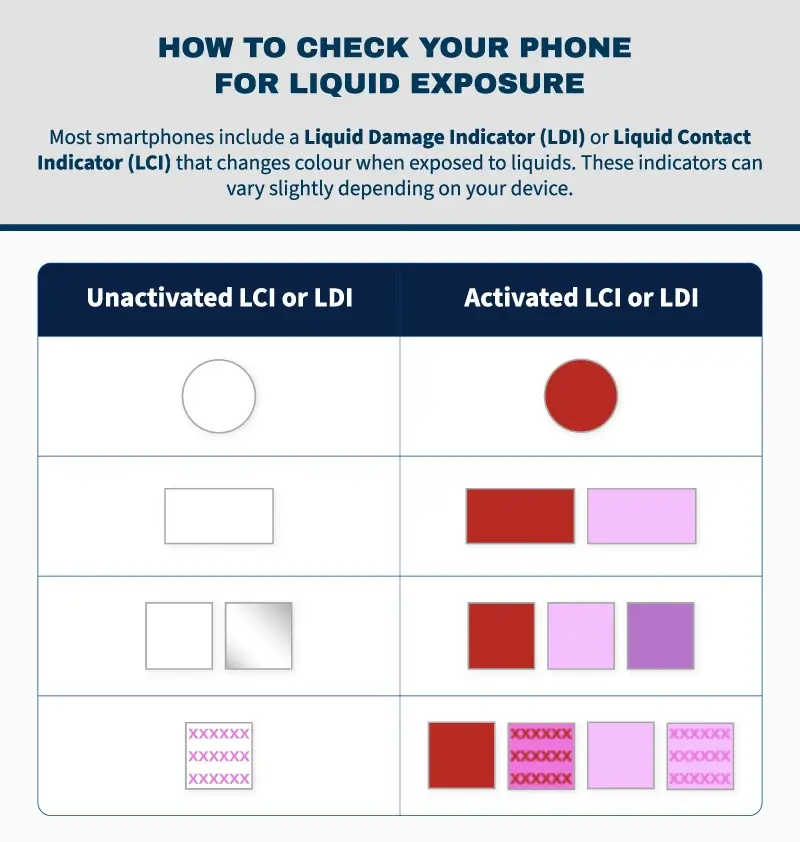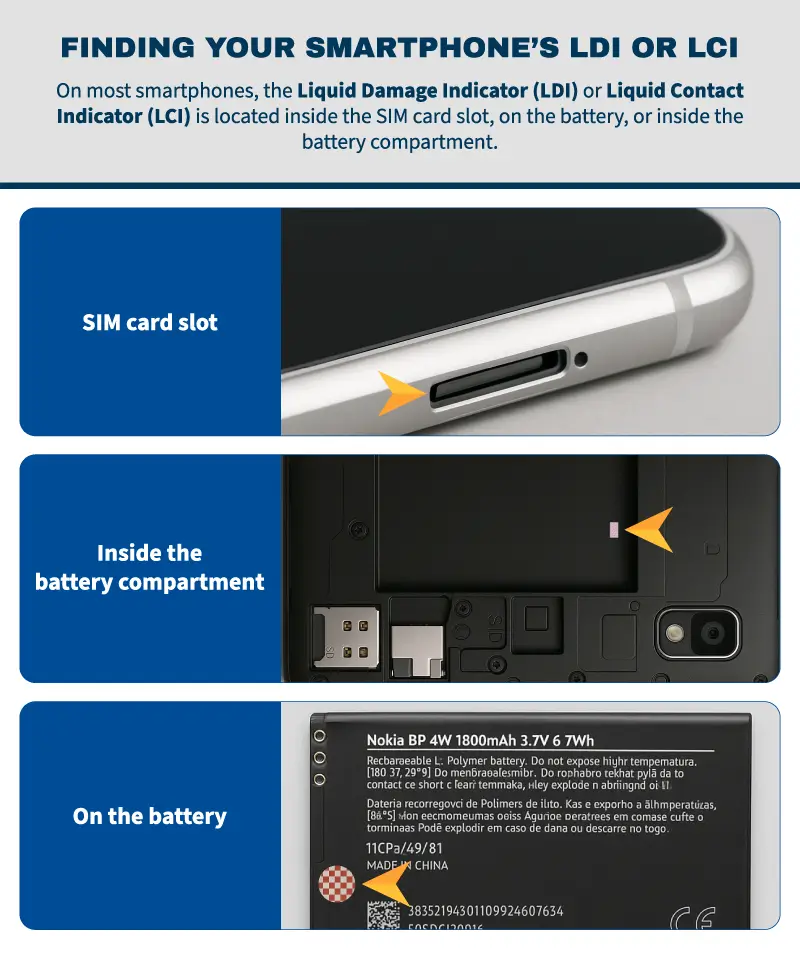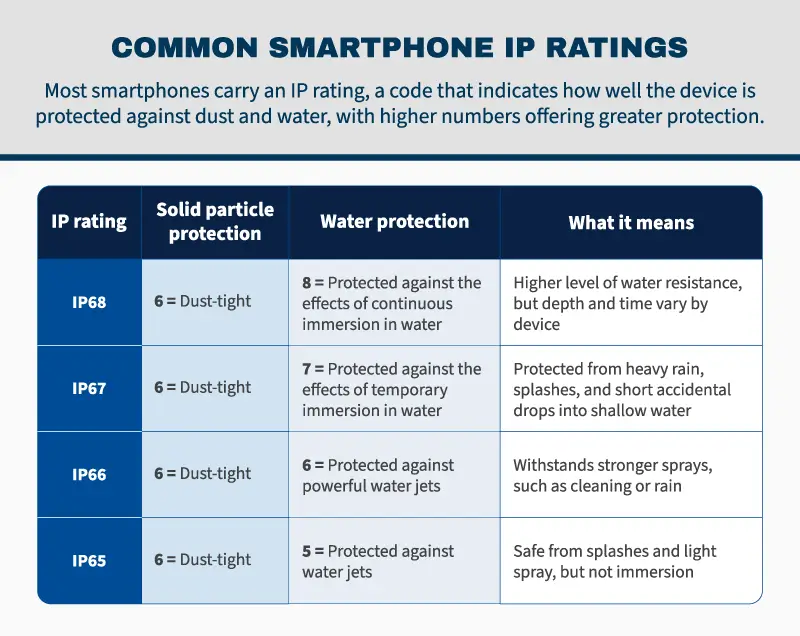Few things trigger panic quite like watching your mobile phone slip into water. Whether it’s a pool, puddle, or the ocean, liquid exposure can have serious consequences for your device’s performance — and more critically — your data. While many modern smartphones are advertised as water-resistant, that protection has limits. Once moisture breaches the internal components, it can quietly degrade functionality, disrupt apps, and put your most valuable data at risk.
If you have a water damaged phone, acting fast is key to preventing further damage and improving your chances of recovery. If the damage looks serious and you haven’t backed up your data recently, it’s a good idea to reach out to a professional data recovery service like Secure Data Recovery. Our experts specialise in retrieving data from water damaged iPhones and Android phones.
What to do (and what not to do) if your phone gets water damaged
Accidents happen, and if your phone has come into contact with water, you can take steps to prevent lasting damage. Acting calmly and following the right process can help protect both your device and the data stored on it. In the section below, we’ll guide you through exactly what to do and what not to do, so you can handle the situation with confidence and give your phone the best chance of recovery.
What to do right away
Before powering up, check for any signs that the phone is still wet, such as condensation under the screen, moisture in the camera lens, dampness in the charging port, or a triggered Liquid Damage or Contact Indicator (LDI/LCI). If you’re unsure whether the device is fully dry, it’s safer to wait longer or have the device professionally assessed rather than risk internal damage by powering it up too soon.
What not to do
If your phone contains valuable data or still isn’t responding after a full drying period, it may be too risky to attempt further DIY solutions. In these cases, professional data recovery is often the safest and most effective option if your data isn’t backed up. At Secure Data Recovery, our experts can safely assess and recover data from water damaged devices using advanced tools in a controlled lab environment.
How to identify signs of water damage
Once your phone has been powered off and thoroughly dried — ideally for at least 48 hours — it may be safe to turn it back on. If the device powers up and appears to function normally, that’s a promising sign, but it doesn’t always mean the damage has been resolved. Moisture can continue to affect internal components over time, so it’s important to stay alert for any signs of instability in the days that follow.
The chart below outlines both immediate and delayed symptoms of water damage, organised from least to most threatening. If you notice one of the more serious issues toward the bottom of the list, it’s best to stop using the device and seek professional support rather than risk making the damage worse.
If you turn the phone back on after the full drying period and you don’t notice any of the issues listed below, you’re likely in the clear, but continue to monitor the device closely for at least a few days, just in case symptoms develop over time.
Distorted or muffled sound
If your phone’s speakers or microphone begin sounding quiet, unclear, or crackly, moisture may be trapped inside the audio components. This issue often appears shortly after water exposure, sometimes immediately, or within a few hours. While minor cases may resolve with thorough drying, it’s important to give the phone at least 48 hours to air out fully. If sound problems persist after that time, consult a professional to avoid further damage.
Connectivity problems
Unexpected issues with mobile signal, data connectivity, or SIM card detection can be caused by water affecting the internal antennae or SIM tray connectors. These problems tend to show up a day or more after the incident and may gradually get worse over time. After drying the phone for at least 48 hours, try restarting the device. If the problem continues, it’s best to have it professionally inspected.
Software instability
Lagging performance, unresponsive apps, or unusual system behaviour could be signs of moisture or corrosion inside the phone. These issues tend to appear gradually and may seem minor at first, but they often signal deeper, progressive damage. Once the phone has dried for at least 24 to 48 hours, you can try turning it on, but be sure to monitor its performance closely. If these symptoms persist or worsen after the dying period, seek professional help to prevent permanent data loss.
Unresponsive or flickering screen
A touchscreen that stops responding properly or begins to flicker may be experiencing damage to the digitiser or display connectors caused by moisture. This often occurs within hours of water exposure and is a strong indicator that liquid has reached sensitive internal components. If you notice any display abnormalities, do not attempt to continue using or rebooting the device. Power it off immediately and contact a data recovery specialist for assessment.
Moisture under screen or camera lens
Visible fog, condensation, or water droplets behind the display glass or camera lens are some of the most immediate and obvious signs that water has entered your phone. This typically appears within minutes of exposure and indicates that moisture has likely reached internal components. If you see this, power off the device immediately and avoid using or charging it. Visible internal moisture greatly increases the risk of corrosion, so it’s important to seek professional help as early as possible.
Charging issues
If your phone suddenly won’t charge, charges slowly, or displays a charging error, it could be due to water reaching the charging port or internal power circuitry. These issues can appear right away or within the first 24 hours after exposure and should be treated with caution. If the problem persists after 48 hours of drying, do not plug in the phone or attempt to charge it, as this could cause a short circuit. This is one of the clearest signs that it’s time to stop DIY efforts and contact a recovery specialist immediately.
Overheating or fast battery drain
Unusual heat or rapid battery drain may suggest that water has compromised the battery or power management system. These symptoms can start a few days after the incident and often worsen if the device continues to be used. If your phone begins to overheat or the battery drains significantly faster than usual after a full 48 hour drying period, stop using the phone and do not charge it. Continued use may accelerate the damage or lead to battery failure. Have the device assessed by a professional as soon as possible.
Random restarts or freezing
Unexpected shutdowns, frequent restarts, or freezing during normal use may signal that moisture or corrosion has begun affecting core components. These issues tend to show up one or more days after exposure and often point to deeper, progressive damage. If you experience these symptoms after the drying period, do not continue using or charging the device. Keep the phone powered off and seek professional assistance right away to prevent further damage and protect your data.
Issues near the top of the list may be early warning signs of damage or temporary effects that resolve with proper drying. However, symptoms further down the list often indicate more serious internal exposure and a higher risk of permanent failure. If your phone is showing multiple symptoms, or any from the lower half of the list, it’s best to stop using the device and contact Secure Data Recovery to protect your data before further damage occurs.
If your phone powers on after the full drying period of 48 hours and seems to be working normally, that’s a reassuring sign. In most cases, you’re probably in the clear. That said, it’s still important to monitor the device closely over the following days, as some issues can take time to develop.
If everything appears stable, take the opportunity to back up your data right away to avoid potential data loss. However, if the device behaves unpredictably or shows any signs of instability, professional repairs and support is the safest option to protect your files and ensure nothing important is lost.
How to check your phone for liquid exposure
Most smartphones are equipped with a small Liquid Damage Indicator (LDI) or Liquid Contact Indicator (LCI), which is a discreet sticker placed inside the device that changes colour when exposed to water or other liquids.
Manufacturers use these indicators to determine whether a phone has come into contact with moisture. Typically, the indicator appears white or silver when dry, and turns red, pink, or purple once activated by moisture. If the LDI or LCI is activated, it may void your warranty.
Below, you’ll find guidance on how to locate and interpret the LDI or LCI on popular devices.
In addition to physical indicators, some newer smartphones are equipped with internal moisture sensors that trigger an on-screen notification if liquid is detected, especially in the charging port. This feature is common on devices from Apple, Samsung, and Google, and is designed to prevent short circuits during charging.
If your phone displays a moisture warning, unplug it immediately and allow it to dry thoroughly before attempting to charge again. Even if the device appears to be working normally, this notification is a clear sign that moisture has been detected and should not be ignored.
If your phone’s indicator has been triggered, or if you’re noticing any signs of water-related issues, the safest course of action is to power off the device, avoid charging, and get it professionally assessed.
How to read IP-ratings and what they mean for your phone
Smartphones today are often advertised as “water-resistant,” but that doesn’t mean they’re waterproof. Popular devices like the iPhone, Samsung Galaxy, Google Pixel, and others may come with an IP-rating, which offers some insight into how well the device is protected against dust and water, but it’s crucial to understand what that rating actually means.
IP stands for Ingress Protection, a standard set by the International Electrotechnical Commission (IEC). An IP-rating typically consists of two numbers:
The higher each number is, the better the level of protection the device offers in that category.
If your phone has already been exposed to water, checking its IP-rating can help you understand how well it was designed to handle that kind of incident and how concerned you should be about potential internal damage.
While an IP-rating doesn’t guarantee protection, it can give you a sense of whether your device was built to survive splashes, brief submersion, or nothing at all. This information is particularly helpful when deciding whether it’s safe to power on the phone and continue using it, or whether it’s better to wait or seek professional help first.
The chart below breaks down some of the most common smartphone IP-ratings, along with what they’re designed to withstand.
IP68-rated
An IP68-rated device offers one of the highest levels of ingress protection available in consumer smartphones. The first digit (6) means the device is completely dust-tight, preventing any particles from entering. The second digit (8) indicates protection against continuous immersion in water, though the exact depth and duration are defined by the manufacturer. While this rating provides strong protection in the event of accidental drops into water, it’s not intended for regular or intentional underwater use. Exposure to saltwater, soapy water, or chlorinated water can still cause damage, as these substances can corrode internal components even in well-sealed devices.
IP67-rated
A smartphone with an IP67 rating is also completely dust-tight (6) and provides protection against temporary immersion in water (7). This rating is common among many modern smartphones and offers reliable protection against splashes, spills, rain, and brief drops into water, such as a sink or bathtub. However, the device is not designed for extended or deep submersion. Prolonged exposure to water, especially under pressure or in non-freshwater environments, may still cause damage.
IP66-rated
Devices rated IP66 are fully protected from dust (6) and can withstand powerful water jets (6) from any direction. This makes them suitable for wet environments, including rain or cleanings. It offers stronger water resistance than IP65, particularly in conditions involving heavier water splashes. However, this rating does not protect against submersion, so the phone should not be dropped or used underwater.
IP65-rated
An IP65-rated phone is completely sealed against dust (6) and can resist low-pressure water jets (5) from any angle. This includes light rain, brief splashes, or quick rinses under a tap. While this offers better protection than lower IP-ratings, it is still not safe for even a brief submersion in water. If a phone with this rating is dropped in water or intentionally submerged, internal damage is likely.
While most devices do offer some level of protection against water, even high-rated devices (including those with an IP68-rating) are not completely waterproof. Most manufacturers, including Apple and Samsung, explicitly state that their warranties exclude water or liquid damage, regardless of how the device is advertised. This means that even if your phone is marketed as water-resistant, you may still be responsible for repairs or data recovery if moisture causes internal failure.
It’s also important to note that IP-ratings are tested in lab conditions using fresh water, however different liquids can have varying impacts to your phone’s components and performance. Fresh water from the sink or rain tends to be less damaging, especially if the device is dried quickly.
Saltwater, on the other hand, is much more harmful. It is highly conductive and corrosive, which means it can begin damaging your phone’s internal components almost immediately. If your phone has been exposed to saltwater, it is especially important to power it off, avoid charging, and seek professional help as soon as possible to reduce the risk of corrosion and data loss.
How to check your phone’s IP-rating
Not sure how water-resistant your phone actually is? Follow the steps below to check your phone’s IP-rating and understand what level of protection it offers against dust and water exposure.
1. Check the manufacturer’s website
Start by visiting the official product page for your device. Look under sections such as “Specifications,” “Water and Dust Resistance,” or “Materials & Durability.” Most major brands, including Apple, Samsung, and Google, have online resources to help you easily find the IP-rating for your specific device.
2. Look on the original packaging
Retail boxes and product pamphlets often list the IP-rating as part of the phone’s feature summary. If you still have the box your phone came in, this can be a quick way to verify the level of protection it offers.
3. Avoid relying on marketing language
Terms like “splash-resistant” or “water-repellent” may sound reassuring, but they are not the same as an official IP certification. Only a formal IP-rating confirms that the device has been tested under controlled conditions to meet specific protection standards.
If your device has sustained water damage beyond what its IP-rating is designed to withstand, it’s best to err on the side of caution and seek professional help. Warranty coverage typically doesn’t apply in cases of liquid damage, even for IP-rated devices.
Water damage doesn’t have to mean data loss
When a phone is exposed to water, taking deliberate action can make all the difference. Powering it off, keeping it dry, and avoiding the urge to charge it are simple but essential steps that help prevent further damage. Even phones with water-resistant ratings are not immune to internal issues, and signs of damage don’t always appear right away. Acting early gives you the best chance to protect both your device and the data stored on it.
At Secure Data Recovery, we specialise in recovering valuable data from water damaged iPhones and Android phones of all models. We can also recover data from MacBooks that have suffered a water spill. Our certified technicians use advanced tools to safely retrieve files. If your phone has come into contact with water, turn it off and contact our team. We’re here to help when it matters most.














